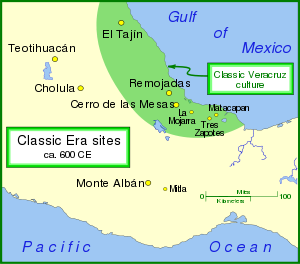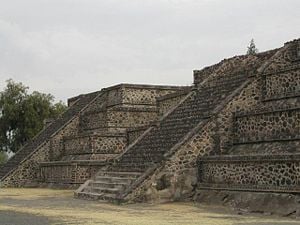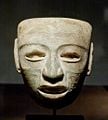Difference between revisions of "Teotihuacan" - New World Encyclopedia
({{Contracted}}) |
|||
| Line 88: | Line 88: | ||
*{{cite book |author={{aut|Weaver, Muriel Porter}} | year = 1993 | title = The Aztecs, Maya, and Their Predecessors: Archaeology of Mesoamerica | edition = 3rd ed. | publisher = Academic Press | location = San Diego | isbn =0-012-63999-0}} | *{{cite book |author={{aut|Weaver, Muriel Porter}} | year = 1993 | title = The Aztecs, Maya, and Their Predecessors: Archaeology of Mesoamerica | edition = 3rd ed. | publisher = Academic Press | location = San Diego | isbn =0-012-63999-0}} | ||
| − | + | ||
| − | |||
| − | |||
==External links== | ==External links== | ||
Revision as of 01:04, 24 August 2007
| Pre-Hispanic City of Teotihuacán* | |
|---|---|
| UNESCO World Heritage Site | |
| State Party | |
| Type | Cultural |
| Criteria | i, ii, iii, iv, vi |
| Reference | 414 |
| Region** | Latin America and the Caribbean |
| Inscription history | |
| Inscription | 1987 (11th Session) |
| * Name as inscribed on World Heritage List. ** Region as classified by UNESCO. | |
Teotihuacán[1] [teotiwa'kan] was, at its height in the first half of the 1st millennium CE, the largest pre-Columbian city in the Americas. The name Teotihuacán is also used to refer to the civilization or culture that this city was the center of, which at its greatest extent included much of central Mexico. Its influence spread throughout Mesoamerica; evidence of Teotihuacano presence, if not outright political and economic control, can be seen at numerous sites in Veracruz and the Maya region.
The city was located in what is now the San Juan Teotihuacán municipality in the State of México, Mexico, approximately 40 km (about 24.8 miles) northeast of Mexico City. It covers a total surface area of 83 km² and was made a UNESCO World Heritage Site in 1987.
Name
The name Teotihuacán was given by the Nahuatl-speaking Aztec centuries after the fall of the city. The term has been glossed as 'birthplace of the gods,' reflecting Nahua creation myths that took place in Teotihuacán. Another translation was offered by Thelma Sullivan, who interprets the name as "place of those who have the road of the gods." [citation needed]
The original name of the city is unknown, but it appears in hieroglyphic texts from the Maya region as 'puh', or Place of Reeds.[citation needed] This suggests that the Maya understood Teotihuacán as a 'Place of Reeds' similar to other Central Mexican settlements that took the name 'Tollan,' such as Tula-Hidalgo and Cholula. This naming convention led to much confusion in the early 20th century as scholars debated whether Teotihuacán or Tula-Hidalgo was the Tollan described by 16th century chronicles. It now seems clear that 'Tollan' may be understood as a generic term applied to any large settlement, rather like the modern expression "the Big Smoke." In the Mesoamerican concept of urbanism, Tollan and other language equivalents serve as a metaphor, linking the bundles of reeds and rushes that formed part of the lacustrine environment of the Valley of Mexico and the large gathering of people in a city.[2]
History
Origins and foundation
The early history of Teotihuacán is quite mysterious, and the origin of its founders is debated. For many years, archaeologists believed it was built by the Toltec people, an early Mexican civilization. This belief was based on Aztec writings which attributed the site to the Toltecs. However, the Nahuatl word "Toltec" means "great craftsman" and may not always refer to the Toltec civilization. Also, Teotihuacán predates the Toltec civilization, ruling them out as the city's founders. [citation needed] Other scholars have put forth the Totonac people as the founders of Teotihuacán, and the debate continues to this day. There is evidence that at least some of the people living in Teotihuacán came from areas influenced by the Teotihuacano civilization, including the Zapotec, Mixtec and Maya peoples. The culture and architecture of Teotihuacán was influenced by the Olmec people, who are considered to be the "mother civilization" of Mesoamerica. The earliest buildings at Teotihuacán date to about 200 B.C.E., and the largest pyramid, the Pyramid of the Sun, was completed by 100 C.E.
Zenith
The city reached its zenith between 150 and 450 C.E., when it was the center of a powerful culture that dominated Mesoamerica, wielding power and influence comparable to ancient Rome. At its height the city covered over 30 km² (over 11½ square miles), and probably housed a population of over 150,000 people, possibly as many as 250,000.[3]. Various districts in the city housed people from across the Teotihuacano empire that spread south as far as Guatemala. Notably absent from the city are fortifications and military structures. Teotihuacán had a major influence on the Preclassic and Classic Maya, conquering several Maya centers including Tikal and influencing Maya culture. The Teotihuacano style of architecture was a major contribution to Mesoamerican culture. The stepped pyramids that were quite prominent in Maya and Aztec architecture came from Teotihuacán. [citation needed] This style of building was called "talud-tablero," where a rectangular panel (tablero) was placed over a sloping side (talud). The city was a center of industry, home to many potters, jewelers and craftsmen. Teotihuacán is known for producing a great number of obsidian artifacts. Unfortunately no ancient Teotihuacano non-ideographic texts are known to exist (or known to have existed), but mentions of the city in inscriptions from Maya cities show that Teotihuacán nobility travelled to and perhaps conquered local rulers as far away as Honduras. Maya inscriptions mention an individual nicknamed by scholars as "Spearthrower Owl," apparently ruler of Teotihuacán, who reigned for over 60 years and installed his relatives as rulers of Tikal and Uaxactún in Guatemala. Most of what we infer about the culture at Teotihuacán comes from the murals that adorn the site and others, like the Wagner Murals, found in private collections, and from hieroglyphic inscriptions made by the Maya describing their encounters with Teotihuacano conquerors.
Collapse
It was previously believed that sometime during the 7th or 8th centuries, the city was sacked and burned by invaders, possibly the Toltecs. More recent evidence, however, seems to indicate that the burning was limited to the structures and dwellings associated primarily with the elite class. Some see this as evidence that the burning was from an internal uprising and that the invasion theory is flawed due to the fact that early archaeological work on the city was focused exclusively on the palaces and temples, places used by the elites, and because all of these sites showed burning, archaeologists concluded that the whole city was burned. Instead, it is now known that the destruction in the city was focused on major civic structures along the Avenue of the Dead. Some statues seem to have been destroyed in a methodical way, their fragments dispersed. The fact that population began to decline around 500-600 C.E. also supports the internal unrest hypothesis. The decline of Teotihucán has been correlated with the droughts related to the Climate changes of 535–536. This theory is supported by the archeological remains that show a rise in the percentage of juvenile skeletons with evidence of malnutrition during the 6th century. This does not conflict with either of the above theories however since both increased warfare and internal unrest can also be effects of a general period of drought and famine. [4] Other nearby centers like Cholula, Xochicalco, and Cacaxtla attempted to fill the powerful vacuum left by Teotihuacán's decline. They may have aligned themselves against Teotihuacán in an attempt to reduce its influence and power. The art and architecture at these sites shows an interest in emulating Teotihuacán forms, but also a more eclectic mix of motifs and iconography from other parts of Mesoamerica, particularly the Maya region.
Teotihuacano culture
People
There is archaeological evidence that Teotihuacán was a multi-ethnic city, with distinct Zapotec, Mixtec, Maya and what seem to be Nahua quarters. The Totonacs have always maintained that they were the ones who built it, a story that was corroborated later by the Aztecs.
Language
In his 2001 paper,[5] Terrence Kaufman presents linguistic evidence suggesting that an important ethnic group in Teotihuacán was of Totonacan and/or Mixe-Zoquean linguistic affiliation. He uses this to explain general influences from Totonacan and Mixe-Zoquean languages in many other Mesoamerican languages many of which do not have any known history of contact with either of the above mentioned groups.
Religion
The religion of Teotihuacán is similar to those of other Mesoamerican cultures. Many of the same gods were worshiped, including the Feathered Serpent and The Rain god. Teotihuacán was a major religious center, and the priests probably had a great deal of political power. As with other Mesoamerican cultures, Teotihuacános practiced human sacrifice. Human bodies and animal sacrifices have been found during excavations of the pyramids at Teotihuacán; it is believed that when the buildings were expanded, sacrifices were made to dedicate the new building. The victims were probably enemy warriors captured in battle and then brought to the city to be ritually sacrificed so the city could prosper. Some were decapitated, some had their hearts removed, others were killed by being hit several times over the head and some were even buried alive. Animals that were considered sacred and represented mythical powers and military might were also buried alive but imprisoned in cages: cougars, a wolf, eagles, a falcon, an owl, and even venomous snakes.
Site layout
The city's broad central avenue, called "Avenue of the Dead" (a translation from its Nahuatl name Miccaotli), is flanked by impressive ceremonial architecture, including the immense Pyramid of the Sun (second largest in the New World after the Great Pyramid of Cholula) and the Pyramid of the Moon. Along the Avenue of the Dead are many smaller talud-tablero platforms. The Aztecs believed they were tombs, inspiring the name of the avenue. Now they are known to be ceremonial platforms that were topped with temples. Further down the Avenue of the Dead is the area known as the Citadel, containing the ruined Temple of the Feathered Serpent. This area was a large plaza surrounded by temples that formed the religious and political center of the city. The name "Citadel" was given to it by the Spanish, who believed it was a fort. Many of the rich and powerful Teotihuacanos lived in Palaces near the temples. The largest of these cover more than 3300 sq. meters [6]. Most of the common people lived in large apartment buildings spread across the city. Many of the buildings contained workshops that produced pottery and other goods.
The geographical layout of Teotihuacán is a good example of the Mesoamerican tradition of planning cities, settlements and buildings as a representation of the Teotihuacano view of the Universe. Its urban grid is aligned to precisely 15.5º east of north. The Street of the Dead, in particular, seems to line up with Cerro Gordo to the north of the Pyramid of the Moon. Pecked-cross circles throughout the city and in the surrounding regions indicate how the grid was managed over long distances.
Archaeological site
Knowledge of the huge ruins of Teotihuacán was never lost. After the fall of the city, various squatters lived on the site. During Aztec times, the city was a place of pilgrimage and identified with the myth of Tollan, the place where the sun was created. Teotihuacán astonished the Spanish conquistadores during the Contact era. Today Teotihuacán is one of the most noted archaeological attractions in Mexico.
Excavations and investigations
Minor archaeological excavations were conducted in the 19th century, and in 1905 major projects of excavation and restoration began under archaeologist Leopoldo Batres. The Pyramid of the Sun was restored to celebrate the centennial of Mexican Independence in 1910. Major programs of excavation and restoration were carried out in 1960-65 and 1980-82. Recent projects at the Pyramid of the Moon and the Pyramid of the Feathered Serpent have greatly expanded evidence of cultural practices. Teotihuacán features museums and reconstructed structures.
Gallery
- Teotihuacan.jpg
Notes
- ↑ The name is often spelled with an orthographic accent on the last syllable, following the spelling and pronunciation of the name in Spanish. However, the name is pronounced [teoti'wakan] in Nahuatl, with the accent on the syllable wa, and by normal Nahuatl orthographic conventions a written accent would not appear in that position. Both pronunciations are used, and both spellings appear in this article.
- ↑ Miller and Taube (1993), p.170.
- ↑ Malstrom, p. 105 gives a figure of 50,000 to 200,000. Coe et al. (1986) says it "might lie between 125,000 and 250,000".
- ↑ Kaufman 2001 p.4
- ↑ Kaufman's paper entitled "Nawa linguistic prehistory" can be read as a .pdf file on the site of the MLDP, following this link.
- ↑ Readers Digest, p.116
ReferencesISBN links support NWE through referral fees
- Berrin, Kathleen and and Esther Pasztory (1993). Teotihuacán: Art from the City of the Gods.
- Brown, Dale M. (ed.) (1992). Lost Civilizations: Aztecs: Reign of Blood and Splendor. Alexandria, VA: Time-Life Books.
- Coe, Michael D. and and Rex Koontz [1962] (2002). Mexico: From the Olmecs to the Aztecs. New York: Thames & Hudson.
- Coe, Michael D. and Dean Snow and Elizabeth Benson (1986). Atlas of Ancient America. New York: Facts on File. ISBN 0-816-01199-0.
- Kaufman, Terrence (2001). Nawa linguistic prehistory. Mesoamerican Language Documentation Project.
- Malmström, Vincent H. (1978). Architecture, Astronomy, and Calendrics in Pre-Columbian Mesoamerica. Journal for the History of Astronomy 9: 105–116.
- Miller, Mary and and Karl Taube (1993). The Gods and Symbols of Ancient Mexico and the Maya. London: Thames and Hudson. ISBN 0-500-05068-6.
- Reader's Digest Association (1978). The World's Last Mysteries. Pleasantville, NY: Reader's Digest Association.
- Weaver, Muriel Porter (1993). The Aztecs, Maya, and Their Predecessors: Archaeology of Mesoamerica, 3rd ed., San Diego: Academic Press. ISBN 0-012-63999-0.
External links
- Teotihuacán Photo Gallery
- Teotihuacán at Sacred Destinations
- Did Teotihuacános Migrate to Southeastern U.S.?
- Satellite View of Teotihuacán - at WikiMapia = Google maps + wiki
- MesoAmerican Photo Archives: Teotihuacán
| Pre-Columbian Civilizations and Cultures | ||||
| North America | Ancient Pueblo (Anasazi) – Fremont – Mississippian | |||
| Mesoamerica | Huastec – Izapa – Mixtec – Olmec – Pipil – Tarascan – Teotihuacán – Toltec – Totonac – Zapotec | |||
| South America | Norte Chico – Chavín – Chibcha – Chimor – Chachapoya – Huari – Moche – Nazca – Tairona – Tiwanaku | |||
| Main civilizations | ||||
| The Aztec Empire | The Maya civilization | The Inca Empire | ||
| Language | Nahuatl language | Mayan languages | Quechua | |
| Writing | Aztec writing | Mayan writing | ||
| Religion | Aztec religion | Maya religion | Inca religion | |
| Mythology | Aztec mythology | Maya mythology | Inca mythology | |
| Calendar | Aztec calendar | Maya calendar | ||
| Society | Aztec society | Maya society | Inca society | |
| Infrastructure | Chinampas | Maya architecture | Inca architecture Inca road system | |
| History | Aztec history | Inca history | ||
| Conquest | Spanish conquest of Mexico Hernán Cortés |
Spanish conquest of Yucatán Francisco de Montejo Spanish conquest of Guatemala Pedro de Alvarado |
Spanish conquest of the Inca Empire Francisco Pizarro | |
| People | Moctezuma I Moctezuma II Cuitláhuac Cuauhtémoc |
Pacal the Great Tecun Uman |
Manco Capac Pachacutec Atahualpa | |
| See also | ||||
| Indigenous peoples of the Americas – Population history of American indigenous peoples – Pre-Columbian art | ||||
Credits
New World Encyclopedia writers and editors rewrote and completed the Wikipedia article in accordance with New World Encyclopedia standards. This article abides by terms of the Creative Commons CC-by-sa 3.0 License (CC-by-sa), which may be used and disseminated with proper attribution. Credit is due under the terms of this license that can reference both the New World Encyclopedia contributors and the selfless volunteer contributors of the Wikimedia Foundation. To cite this article click here for a list of acceptable citing formats.The history of earlier contributions by wikipedians is accessible to researchers here:
The history of this article since it was imported to New World Encyclopedia:
Note: Some restrictions may apply to use of individual images which are separately licensed.






